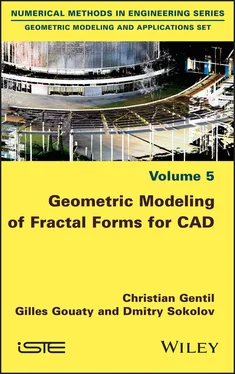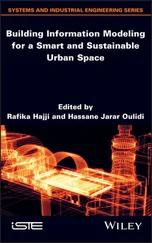1 Cover
2 Table of Contents
3 Title page Geometric Modeling and Applications Set coordinated by Marc Daniel Volume 5
4 Copyright First published 2021 in Great Britain and the United States by ISTE Ltd and John Wiley & Sons, Inc. Apart from any fair dealing for the purposes of research or private study, or criticism or review, as permitted under the Copyright, Designs and Patents Act 1988, this publication may only be reproduced, stored or transmitted, in any form or by any means, with the prior permission in writing of the publishers, or in the case of reprographic reproduction in accordance with the terms and licenses issued by the CLA. Enquiries concerning reproduction outside these terms should be sent to the publishers at the undermentioned address: ISTE Ltd 27-37 St George’s Road London SW19 4EU UK www.iste.co.uk John Wiley & Sons, Inc. 111 River Street Hoboken, NJ 07030 USA www.wiley.com © ISTE Ltd 2021 The rights of Christian Gentil, Gilles Gouaty and Dmitry Sokolov to be identified as the authors of this work have been asserted by them in accordance with the Copyright, Designs and Patents Act 1988. Library of Congress Control Number: 2021932086 British Library Cataloguing-in-Publication Data A CIP record for this book is available from the British Library ISBN 978-1-78630-040-9
5 Preface
6 Introduction
7 Begin Reading
8 Conclusion
9 Appendix
10 References
11 Index
12 Other titles from ISTE in Numerical Methods in Engineering
13 End User License Agreement
1 v
2 iii
3 iv
4 ix
5 x
6 xi
7 xii
8 xiii
9 xiv
10 1
11 2
12 3
13 4
14 5
15 6
16 7
17 8
18 9
19 10
20 11
21 12
22 13
23 14
24 15
25 16
26 17
27 18
28 19
29 20
30 21
31 22
32 23
33 24
34 25
35 26
36 27
37 28
38 29
39 30
40 31
41 32
42 33
43 34
44 35
45 36
46 37
47 38
48 39
49 40
50 41
51 42
52 43
53 44
54 45
55 46
56 47
57 48
58 49
59 50
60 51
61 52
62 53
63 54
64 55
65 56
66 57
67 58
68 59
69 60
70 61
71 62
72 63
73 64
74 65
75 66
76 67
77 68
78 69
79 70
80 71
81 72
82 73
83 74
84 75
85 76
86 77
87 78
88 79
89 80
90 81
91 82
92 83
93 84
94 85
95 87
96 88
97 89
98 90
99 91
100 92
101 93
102 94
103 95
104 96
105 97
106 98
107 99
108 100
109 101
110 102
111 103
112 104
113 105
114 106
115 107
116 108
117 109
118 110
119 111
120 112
121 113
122 114
123 115
124 116
125 117
126 118
127 119
128 120
129 121
130 122
131 123
132 124
133 125
134 126
135 127
136 128
137 129
138 130
139 131
140 132
141 133
142 134
143 135
144 136
145 137
146 138
147 139
148 140
149 141
150 142
151 143
152 144
153 145
154 146
155 147
156 148
157 149
158 150
159 151
160 152
161 153
162 154
163 155
164 156
165 157
166 158
167 159
168 160
169 161
170 162
171 163
172 164
173 165
174 166
175 167
176 168
177 169
178 170
179 171
180 172
181 173
182 174
183 175
184 176
185 177
186 178
187 179
188 180
189 181
190 182
191 183
192 184
193 185
194 186
195 187
196 188
197 189
198 190
199 191
200 192
201 193
202 194
203 195
204 196
205 197
206 198
207 199
208 200
209 201
210 202
211 203
212 204
213 205
214 206
215 207
216 208
217 209
218 210
219 211
220 212
221 213
222 215
223 216
224 217
225 218
226 219
227 220
228 221
229 223
230 224
231 225
232 226
233 227
234 229
235 230
236 231
237 232
238 233
Geometric Modeling and Applications Set
coordinated by
Marc Daniel
Volume 5
Geometric Modeling of Fractal Forms for CAD
Christian Gentil
Gilles Gouaty
Dmitry Sokolov

First published 2021 in Great Britain and the United States by ISTE Ltd and John Wiley & Sons, Inc.
Apart from any fair dealing for the purposes of research or private study, or criticism or review, as permitted under the Copyright, Designs and Patents Act 1988, this publication may only be reproduced, stored or transmitted, in any form or by any means, with the prior permission in writing of the publishers, or in the case of reprographic reproduction in accordance with the terms and licenses issued by the CLA. Enquiries concerning reproduction outside these terms should be sent to the publishers at the undermentioned address:
ISTE Ltd
27-37 St George’s Road
London SW19 4EU
UK
www.iste.co.uk
John Wiley & Sons, Inc.
111 River Street
Hoboken, NJ 07030
USA
www.wiley.com
© ISTE Ltd 2021
The rights of Christian Gentil, Gilles Gouaty and Dmitry Sokolov to be identified as the authors of this work have been asserted by them in accordance with the Copyright, Designs and Patents Act 1988.
Library of Congress Control Number: 2021932086
British Library Cataloguing-in-Publication Data
A CIP record for this book is available from the British Library
ISBN 978-1-78630-040-9
This work introduces a model of geometric representation for describing and manipulating complex non-standard shapes such as rough surfaces or porous volumes. It is aimed at students in scientific education (mathematicians, computer scientists, physicists, etc.), engineers, researchers or anyone familiar with the mathematical concepts addressed at early stages of the graduate level. However, many parts are accessible to all, in particular, all introductory sections that present ideas with examples. People with no prior background, whether they are artists, designers or simply curious, will be able to understand the philosophy of our approach, and discover a new universe of unsuspected and exciting forms.
Geometric representation models are mathematical tools integrated into computer-aided geometric design (CAGD) software. They make the production of numerical representations of forms possible. By means of graphical interfaces or programming tools, users can draw and/or manipulate these shapes. They can also test or evaluate their physical properties (mechanical, electro-magnetic, acoustic, etc.) by communicating geometric descriptions to further specific numerical simulation software.
The geometric representation model we present here is based on the fractal geometry paradigm. The principle behind this consists of studying the properties (signal, geometry, phenomena, etc.) at different scales and identifying the invariants from there. The objects are described as self-referential between two scales: each of the object features (namely, the lower scale level) is described as a reference to the object itself (namely, the higher scale). This approach is not conventional and often confusing at first. We come to perceive its richness and power very quickly, however. The universe of forms that can possibly be created is infinite and has still only partially been explored.
Читать дальше













